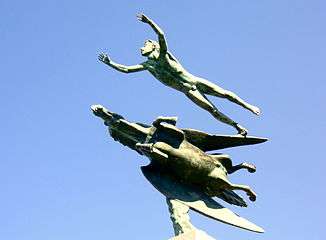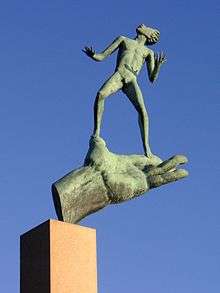Carl Milles

Carl Milles (23 June 1875 – 19 September 1955) was a Swedish sculptor. He was married to artist Olga Milles and brother to Ruth Milles and half brother to the architect Evert Milles. Carl Milles sculpted the Poseidon statue in Gothenburg, the Gustaf Vasa statue at the Nordic Museum, the Orpheus group outside the Stockholm Concert Hall and the Folke Filbyter sculpture in Linköping. The latter was featured on a stamp issued in 1975 commemorating the centenary of his birth. Millesgården became his last home and is now a museum.
Biography

Milles was born Carl Wilhelm Andersson, son of lieutenant Emil "Mille" Andersson and his wife Walborg Tisell, (June 23, 1875 – September 19, 1955) at Lagga outside Uppsala in 1875. In 1897 he made what he thought would be a temporary stop in Paris on his way to Chile, where he was due to manage a school of gymnastics. However, he remained in Paris, where he studied art, working in Auguste Rodin's studio and slowly gaining recognition as a sculptor. In 1904 he and Olga moved to Munich.
Two years later they settled in Sweden, buying property on Herserud Cliff on Lidingö, a large island near Stockholm. Millesgården was built there between 1906 and 1908 as the sculptor's private residence and workspace. It was turned into a foundation and donated to the Swedish people in 1936, five years after Milles had sailed for America and the Cranbrook Academy of Art in Bloomfield Hills.
Milles in America

In 1931, American publisher George Gough Booth brought Milles to Cranbrook Educational Community, in Bloomfield Hills, Michigan, to serve as his sculptor in residence.[1] Part of Booth's arrangement with his principal artists was that they were expected to create major commissions outside the Cranbrook environment.[2]
In 1938, for the 300th anniversary of the founding of New Sweden, the country commissioned a sculpture by Milles featuring a replica of the Kalmar Nyckel, the ship which originally brought the Swedish colonists to America. The sculpture is located at Fort Christina in Wilmington, Delaware near the landing site where the colonists arrived in 1638.
In America he is best known for his fountains. Milles' fountain group The Wedding of the Waters in St. Louis symbolizes the Missouri and Mississippi Rivers merging just upstream. Commissioned in 1936 and unveiled in May 1940 to a crowd of about 3000 people, the fountain caused a local uproar because of its playful, irreverent, naked, and nearly cartoonish figures, and because Milles had conceived the group as a wedding party. Local officials insisted that the name be changed to The Meeting of the Waters.
Outside the Detroit's Frank Murphy Hall of Justice is a Carl Milles statue, The Hand of God, which was sculpted in honor of Frank Murphy, Detroit Mayor, Michigan Governor and United States Supreme Court Associate Justice. The statue was placed on a pedestal with the help of sculptor Marshall Fredericks. The statue was commissioned by the United Automobile Workers,[3] and paid for by individual donations from UAW members.[4] The annual Global Award for Entrepreneurship Research is an award for research on entrepreneurship. It consists of a statuette replica of The Hand of God and a prize sum of 100,000 euros.
Milles' sculptures sometimes offended American sensibilities, and he had a 'fig leaf' maker on retainer.[1]
Photographs of his sculptures, taken for a monograph on Milles, are now held in the Carl Milles Photograph Collection, c. 1938–1939, in the Ryerson & Burnham Libraries at the Art Institute of Chicago.
Milles' final resting place
Milles and his wife returned to Sweden in 1951, and lived in Millesgården every summer until Milles's death in 1955. They spent winters in Rome, where the American Academy had supplied them with a studio. Milles and his wife, Olga, who died in 1967 in Graz, Austria, are buried in a small stone chapel, designed by Milles, at Millesgården. Because Swedish law requires burial on sacred ground, it took the assistance of the then reigning Gustaf VI Adolf to allow this resting place.
Selected American works


- WWJ Building, Albert Kahn architect, Detroit, Michigan 1936
- Vision of Peace (Indian God of Peace), Saint Paul City Hall and Ramsey County Courthouse, Holabird & Root architects, Saint Paul, Minnesota, 1936
- Racine County Court House, Holabird & Root architects, Racine, Wisconsin 1931
- Swedish Tercentenary Monument, Wilmington, Delaware, 1938
- Doors of Finance Building, Harrisburg, Pennsylvania, 1938
- Playing Angels, Philadelphia, Pennsylvania (1950; purchased by Fairmount Park Art Association in 1968; installed 1972)[5]
- Meeting of the Waters, St. Louis, Missouri 1936–1940
- On a Sunday Morning, Ann Arbor, Michigan 1941
- Numerous works at Cranbrook Educational Community, Bloomfield Hills, Michigan, including Mermaids & Tritons Fountain, 1930, Sven Hedin on a Camel, 1932, Jonah and the Whale Fountain, 1932, Orpheus Fountain, 1936.[2]
- Fountain of Faith, National Memorial Gardens, Falls Church, Virginia 1952
- The Sunsinger, National Memorial Gardens, Falls Church, Virginia 1952
- The Sunsinger Robert Allerton Park, Monticello, Illinois 1929 (modeled after the 1926 original in Stockholm Harbor)[6][7]
- Spirit of Transportation, Detroit Civic Center, Detroit, Michigan 1952
- Volker Memorial Fountain, Kansas City, Missouri 1955
- Triton Blowing a Shell (1916, this cast 1972), Mayo Clinic, Rochester, Minnesota[8]
- Pegasus and Man, Bryan St., Harwood St., Dallas, Texas
- Europa and the Bull, University of Tennessee, Knoxville
- Greendale War Memorial for Veterans of all wars 1948 Worcester, MA
- Man & Nature, 1 Rockefeller Center, New York City, NY
Works
- Carl Milles sculptures
 Poseidon, Gothenburg
Poseidon, Gothenburg Angels playing music, Millesgården, Stockholm
Angels playing music, Millesgården, Stockholm Wild boar, Millesgården, Stockholm.
Wild boar, Millesgården, Stockholm. Millesgården, Stockholm
Millesgården, Stockholm Europa and the Bull, Millesgården, Stockholm.
Europa and the Bull, Millesgården, Stockholm. Millesgården, Stockholm
Millesgården, Stockholm God Father , Nacka Strand
God Father , Nacka Strand Man and Pegasus, Millesgården
Man and Pegasus, Millesgården Millesgården
Millesgården
Sources and references

- Jonsson, Ann, « D’un mythe à l’autre : L’ 'Europe' de Carl Milles et sa symbolique en Suède », in D'Europe à l'Europe, II. Mythe et identité du XIXe s. à nos jours (colloque de Caen, 1999), éd. Rémy Poignault, Françoise Lecocq et Odile Wattel – de Croizant, Tours, Centre Piganiol, coll. Caesarodunum, n° XXXIII bis, 2000, p. 157-162.
- Kvaran, Einar E., An Annoted Inventory of Outdoor Sculpture in Washtenaw County (Masters Thesis. 1989)
- Liden, Elisabeth, Between Water and Heaven, Carl Milles Search for American Commissions, (Almqvist & Wiksell International, Stockholm, Sweden 1986)
- Martenson, Gunilla, A Stockholm Sculpture Garden (New York Times, Dec. 27, 1987)
- Nawrocki, Dennis and Thomas Holleman, Art in Detroit Public Places, (Wayne State University Press, Detroit, Michigan 1980)
- Piland & Uguccioni, Fountains of Kansas City, (City of Fountains Foundation 1985)
- Rogers, Meyric, Carl Milles, An Interpretation of His Work, (Yale University Press, New Haven, Connecticut 1940)
- Taylor, Askew, Croze, et al., Milles At Cranbrook, (Cranbrook Academy of Art, 1961)
- Westbrook, Adele and Anne Yarowsky, Design in America, The Cranbrook Vision 1925–1950, (Detroit Institute)
See also
Notes
- 1 2 "Carl Milles sculptures, Detroit News". Info.detnews.com. 1999-09-06. Retrieved 2012-05-11.
- 1 2 Baulch, Vivian M. (September 6, 1999). "Carl Milles, Cranbrook's favorite sculptor". Michigan History. The Detroit News. Retrieved February 14, 2011.
- ↑ "Monumental Sculptures of Detroit, Detroit News". Info.detnews.com. 1999-09-05. Retrieved 2012-05-11.
- ↑ "Art Inventory, "The Hand of God" by Carl Milles". Siris-artinventories.si.edu. 1970-11-29. Retrieved 2012-05-11.
- ↑ "Playing Angels - Association for Public Art". Retrieved 2016-09-14.
- ↑ "Carl Milles". The New York Times. March 13, 1988.
- ↑ "Carl Milles Gården, in Stockholm". Philip.greenspun.com. 2009-08-19. Retrieved 2012-05-11.
- ↑ Triton Med Snacka, from SIRIS.
Further reading
- Baulch, Vivian M. (September 6, 1999). "Carl Milles, Cranbrook's favorite sculptor". Michigan History. The Detroit News. Retrieved February 14, 2011.
External links
| Wikimedia Commons has media related to Carl Milles. |
